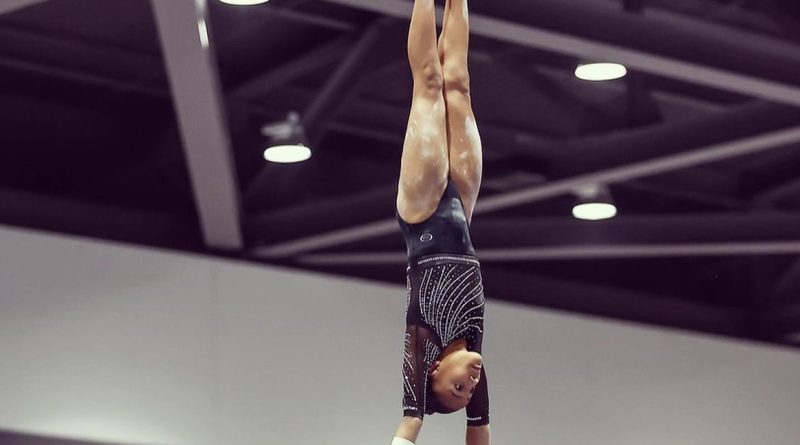Internal Motivation Instead of Internal Pressure
April can be a tough time to be a coach. For some of your gymnasts, it is the final meets of their season – or their career. And they are really feeling the pressure. For others, their season is already done and they are back to basics and working new skills. It can be a lot to manage at once. But when it comes to mindset work, gymnasts in both scenarios are often feeling some of the same things. Pressure. Nervousness. Doubt and Fear. So our focus in April is to help them deal with those emotions and turn them into motivation, excitement and self-confidence. We want to help them create internal motivation instead of internal pressure!
Let’s focus in on four aspects of dealing with nerves and pressure.
Pressure comes from the inside. Gymnasts who are still competing at this point often feel a lot of pressure. Pressure to hit. Pressure to qualify to the next level. Pressure to do their very best. Gymnasts now in their off-season feel pressure to get a new skill. Or to get their skills right away, so they don’t run out of time next year like they did this year.
But your gymnasts don’t realize that they are actually the ones creating the pressure. We always think of pressure as something that comes from outside of us. Pressure from other people – our coaches, parents or teammates. Pressure from the situation. Pressure because the outcome really matters. But pressure is really just a feeling. Usually we describe it as nervous, stressed or anxious. And in mindset training, we know that feelings never come from a situation or other people. If they did, that situation or person’s words would make every single person feel the same way. But they don’t. Because feelings don’t come from outside. They come from our thoughts.
When your gymnasts (or you!) feel pressure, it is important to know that the pressure is actually coming from your own thoughts. And they get to decide if they want to keep choosing the thoughts that lead to the feeling of pressure. Many times your gymnasts choose them because they think it will help them perform better or get better results. But the reality is that anxious, nervous and scared are never feelings that fuel their best work. So first just help them understand that the pressure is actually coming from their own thoughts. And that if it isn’t serving them, they can choose other thoughts instead.
Thoughts like, “No matter what happens I am 100% loved and worthy.”
“I can feel any feeling that comes up.”
“I will have my own back no matter what.”
“I KNOW I can do this. And if I mess up, that’s ok.”
Those thoughts will potentially lead to calm confidence. Which is a much better energy to compete from. And to learn new skills. So when they feel the pressure, take note of the thoughts that are causing it. And then do the mindset work to choose new thought patterns instead. Here are three exercises we use.
#1 Turning Pressure to Motivation
Most of the time, your gymnasts are scared because their brain is offering up a whole slew of scenarios of all the things that could go wrong.
They are imagining a future that they don’t want.
We call them the “What Ifs.”
What if I….
Fall. Make a mistake. Get hurt. Embarrass myself. Disappoint my coaches, parents, teammates. Don’t meet my goals.
When they are just trying not to think about them, or thinking about them all the time, the “What Ifs” are scary. Like when you are lying in bed and you hear a noise and your brain just freezes in fright. But when you get up and turn on the lights, you realize nothing is really wrong. The same thing happens when you look at the “What Ifs.”
First we have our gymnasts write down a list of all the what ifs. And then answer each one. Go to the worst case scenario. After that go back and look at the opposite scenario. And from then on, each time their brain goes to the negative what if, they say yes, but and answer with the positive one. This turns the pressure of the negative future they are imaging into motivation for a positive outcome they want instead.
#2 Turn Nervous to Excited
The things our gymnasts tell us they hate the most about competition or trying to get a new skill is feeling nervousness. They often talk about it as if they can hardly stand it. But the feeling of nervous and the feeling of excited are almost identical experiences in the body. So we work with them to shift their willingness to feel nervous (just like they are willing to feel excited). By having them examine how it feels in their body when they are nervous, and then when they are excited. They discover that it is really similar.
So then we encourage them to do a little brain hack. To tell their brain that the reason they are feeling those butterflies is because they are excited! When you tell your brain you are nervous, your brain looks for all the reasons why you should be nervous. And it gets worried. But when you tell your brain you are excited, it says, “Oh THATS what all those butterflies are about! Ok, all is well, this will be fun!” So we work on shifting their thoughts about being nervous to thoughts about being excited. Or as some of our gymnasts say…. nervcited!
#3 Swap Have to with Want to
The last thing your gymnasts do that creates pressure is telling themselves they have to do something.
I have to hit or I won’t medal. I have to do this routine perfectly or I won’t qualify to the next level. I have to do a good warm up or I will have a horrible routine. I have to get this skill or I won’t be able to compete at the next level. The Have To thoughts always create feelings of pressure, anxiety and fear. And those emotions won’t serve them to actually DO the thing they are thinking they have to do. Which means, they may not get the result they really want. The reality is that they don’t have to do anything.
Gymnastics is not a requirement of life.
They don’t have to come to practice, do their numbers, compete, or do gymnastics at all. And telling yourself that you do just creates unnecessary pressure. Because their subconscious brain doesn’t understand levels of have to. I have to breathe, I have to have water, I have to hit. It just makes them all equal, all life or death “Have to’s.” When your gymnast is honest with themself, they WANT to do these things. Because they want the result they will get if they do them.
They WANT to do gymnastics (or at least they did, back before they were putting so much pressure on themselves!). They do this because it is fun. Because they like challenging themselves. And because it is a great way to spend their life. So help them catch their brain when it says they have to. And tell it the truth. They want to.
Summing it all up
In the end, creating internal pressure never helps with performance. Instead, your gymnasts need to learn how to create internal motivation instead of internal pressure. Hopefully these exercises will help you, help them. If you want more on these lessons, check out the Conversations for Coaches episodes of our podcast Going for Gymnastics Gold.
Blog Article by Stacie Fletcher of Gymnastics Mindset Academy




